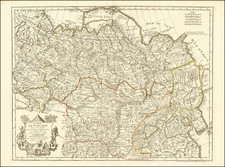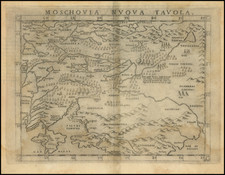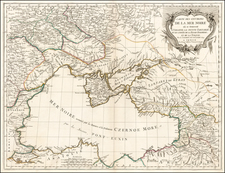Detailed plan of the Battle of Poltava. The Battle of Poltava fought on June 27-28, 1709 was the decisive victory of Peter I of Russia over Charles XII of Sweden in the most famous of the battles of the Great Northern War. While the date given on the map reflects a July 8, 1709 battle, the modern date is given as June 27-28.
After the Battle of Narva in 1700, Czar Peter I was reorganized his army, while Charles XII of Sweden fought for 6 years against Augustus II of Saxony-Poland. Peter first offensive move with his reorganized Russian Army was to establish the city of Saint Petersburg in Swedish territory. Charles attacked the Russian heartland with the intent on an assault on Moscow from Poland. The Swedish army of almost 44,000 men left Saxony on August 22, 1707 and marched eastwards. When they reached the Vistula River and crossed on December 30, then continued through Masuria and took Grodno on January 28, 1708. The Swedes continued to the area around Smorgon and Minsk ,where the army went into winter quarters.
The harsh winter and epidemic diseases ravished the Swedish Army. In early June 1708, the Swedes marched towards Smolensk. While reinforcements and supplies had been sent from Courland, but did not reach the main Swedish forces until October 11. Because of a lack of needed supplies, Charles XII turned south into Ukraine in search of grain and better weather. The Ukrainian forces, under the command of Ivan Mazepa, had been in discussions with Charles and at this point officially allied with the Swedes to gain independence from Russia.
The reinforcements led by General Lewenhaupt followed south and were attacked at Lesnaya. The Swedes were caught by surprise. Lewenhaupt, seeing that he was about to lose, decided to rejoin Charles with all speed, so he abandoned the cannon, the cattle and most of the food, driving the soldiers to mutiny. Stealing all of the alcohol, the soldiers became drunk, and Lewenhaupt was forced to leave about 1,000 men drunk in the woods. When Lewenhaupt reached Charles, no supplies and only 6,000 men remained.
In the spring Charles XII resumed his advance, but his army had been reduced by about one-third due to starvation, frostbite and other effects of the weather. Charles's first action was to lay siege to the fort of Poltava on the Vorskla River in the Ukraine. Peter had already organized a huge force to protect it, and he quickly arrived. On 27 June, Charles received information that large Kalmyk forces were going to join Peter and to cut off all supplies of Swedish Army. Charles had about 14,000 men, while Peter commanded about 45,000.
Charles was wounded during the siege. He turned over command to Field Marshal Carl Gustav Rehnskiöld and General Adam Ludwig Lewenhaupt, which caused many problems. Also the Russians managed to weaken the Cossack forces. The Russian army destroyed the Zaporozhian Host with the help of Galagan, a former Cossack officer. The rest of the Cossacks moved their Host down the Dnieper River river for the next 19 years.
The final battle began on June 28. At first, the Swedes pressed in on the Russians' redoubts. The Swedish infantry, commanded by General Lewenhaupt, attempted to attack the Russians. But the Swedish advance soon faltered, partly because the infantry had been ordered to withdraw and reorganize. To make matters worse, one Swedish detachment, commanded by General Roos, hadn't been told about the overall plan and became isolated in the Russian defensive redoubts when a column of about 4,000 Russian reinforcements reoccupied the fortified positions, trapping Roos and his 2,600-man force. With over 1,000 casualties and ammunition running low, Roos was forced to surrender his command.
The Swedes waited for Roos to return. As time went by, the Russians infantry moved out of its fortified camp. Around 9:00 am, the Swedish line started to move forward; 4,000 Swedish infantry against 20,000 Russian infantry. They advanced and the Russians opened fire on them with their guns. When the Swedes were 100 meters from the Russian line, the Russians fired their muskets. When they were 30 meters from the Russian line, the Swedes fired one volley and charged. They were on the verge of a breakthrough and needed the cavalry; unfortunately for the Swedes, it was disorganized.
The Russian line was longer than the Swedish line, and the Russian right soon flanked the Swedish infantry. Several regiments were surrounded in a classic Cannae-style battle. The cavalry tried to buy the infantry time to get away; several units attacked the Russians head on despite them forming into squares. Seeing the defeat of his army from a stretcher in the rear, Charles ordered the army to retreat at 11:00 a.m.
By noon, the battle was over. Charles retreated to the south later that same day, abandoning Poltava. Rehnskiöld was captured. Lewenhaupt led the surviving Swedish and some of the Cossacks forces to the Dnieper River, but was pursued by the Russian regular cavalry and 3,000 Kalmyks and forced to surrender three days later at Perevolochna, on July 1. Several thousand prisoners were taken. Charles and Mazepa managed to escape with about 1,500 men to Bendery, Moldavia, then controlled by the Ottoman Empire. Charles spent five years in exile there before he was able to return to Sweden.
Nicholas de Fer (1646-1720) was the son of a map seller, Antoine de Fer, and grew to be one of the most well-known mapmakers in France in the seventeenth century. He was apprenticed at twelve years old to Louis Spirinx, an engraver. When his father died in 1673, Nicholas helped his mother run the business until 1687, when he became the sole proprietor.
His earliest known work is a map of the Canal of Languedoc in 1669, while some of his earliest engravings are in the revised edition of Methode pour Apprendre Facilement la Geographie (1685). In 1697, he published his first world atlas. Perhaps his most famous map is his wall map of America, published in 1698, with its celebrated beaver scene (engraved by Hendrick van Loon, designed by Nicolas Guerard). After his death in 1720, the business passed to his sons-in-law, Guillaume Danet and Jacques-Francois Benard.










![[ Southeastern Ukraine / Sea of Azov ] Des Russisch en Reiches Statthalterschaft en Neurussland, Asow, unddas Oestliche Nogay Nro. 62.](https://storage.googleapis.com/raremaps/img/small/101475.jpg)
![[ Earliest Obtainable Map of Russia, Ukraine, and the Caucauses ] Secunda Asiae Tabula](https://storage.googleapis.com/raremaps/img/small/82673.jpg)


![[Kiev Region] Li Palatinati di Braclaw e Kiowia Tratta dell' Atlante Polacco del Sigr Rizzi Zanoni . . . 1781](https://storage.googleapis.com/raremaps/img/small/78390.jpg)